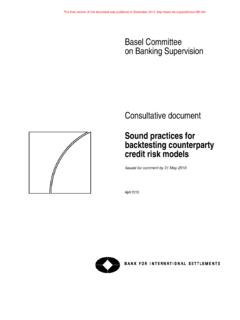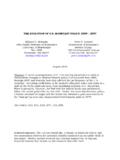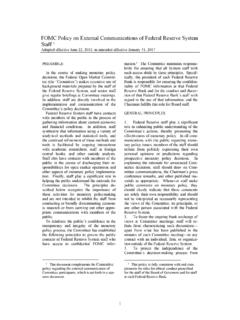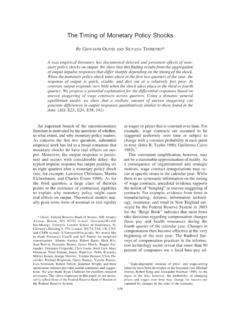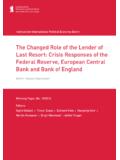Transcription of The Global Factor in Neutral Policy Rates: Some ...
1 1 The Global Factor in Neutral Policy rates : Some implications for exchange rates , monetary Policy , and Policy coordination Richard Clarida* Lowell Harriss Professor of Economics and International Affairs, Columbia University Global Strategic Advisor, PIMCO Research Associate, NBER. May 30, 2017 Abstract This paper highlights some of the theoretical and practical implications for monetary Policy and exchange rates that derive specifically from the presence of a Global general equilibrium Factor embedded in Neutral real Policy rates in open economies. Using a standard two country DSGE model, we derive a structural decomposition in which the nominal exchange rate is a function of the expected present value of future Neutral real interest rate differentials plus a business cycle Factor and a PPP Factor .
2 Country specific r* shocks in general require optimal monetary Policy to pass these through to the Policy rate, but such shocks will also have exchange rate implications , with an expected decline in the path of the real Neutral Policy rate reflected in a depreciation of the nominal exchange rate. We document a novel empirical regularity between the equilibrium error in the VECM representation of the empirical Holston Laubach Williams (2017) four country r* model and the value of the nominal trade weighted dollar. In fact, the correlation between the dollar and the 12 quarter lag of the HLW equilibrium error is estimated to be Global shocks to r* under optimal Policy require no exchange rate adjustment because passing though r* shocks to Policy rates does all the work of maintaining Global equilibrium.
3 We also study a richer model with international spill overs so that in theory there can be gains to international Policy cooperation. In this richer model we obtain a similar decomposition for the nominal exchange rate, but with the added feature that r* in each country is a function Global productivity and business cycle factors even if these factors are themselves independent across countries. We argue that in practice, there could well be significant costs to central bank communication and credibility under a regime formal Policy cooperation, but that gains to Policy coordination could be substantial given that r* s are unobserved but are correlated across countries. *This paper was prepared for the Annual BIS Research Conference held June 23rd, 2017 in Lucerne, Switzerland.
4 The author would like to thank Jordi Gali for sharing his insights on this and related topics. 2 The Global Factor in Neutral Policy rates : Some implications for exchange rates , monetary Policy , and Policy coordination Richard Clarida I. Introduction Over the past 25 years, best practice monetary Policy has been implemented with reference - if not with mechanical adherence - to interest rate feedback rules that Include as inputs estimates of both potential output as well as the real Policy rate - often referred to the " Neutral " real Policy rate and denoted as r* - consistent with potential output and price stability as defined by the central bank's inflation target. Before the Global financial crisis and reflecting the justly deserved influence of Taylor (1993), it was common in Policy simulations (Henderson and McKibbin (1993)) and in empirical work (Clarida, Gali, Gertler (1998;2000)) to make the simplifying assumption that r* is constant.
5 However, it has long been appreciated ( Wicksell (1898) ; Friedman (1968)) that r* can be time varying and in particular, the theoretical analysis of monetary Policy rules in Woodford (2003) and Clarida , Gali, Gertler (1999;2002) - among many others - has emphasized that shocks to r* should be reflected in Policy rates set by central banks seeking to keep the economy as close as possible to the benchmark of a flexible price equilibrium. Since the Global financial crisis , estimated and projected future declines in Neutral real Policy rates (Laubach and Williams (2003); Holston, Laubach, Williams (2017)) ; Hamilton , et. al. (2015)) relative to the pre-crisis experience have become an important consideration in the conduct of monetary Policy and the communication of forward guidance at the Fed and some other major central banks ( Yellen (2017); Haldane (2015)).
6 One obvious and significant implication of a persistent decline in the Neutral real Policy rate in any given country is that such a decline makes it more likely that a central bank will hit the effective - perhaps somewhat less than zero - lower bound for any given inflation target and distribution of shocks . While these lower - bound and choice-of -inflation- target topics are important (and have recently been 3 studied in the open economy context by Cook and Devereux (2013)), they are not the focus of this paper. Instead, the focus of this paper is on highlighting some of the theoretical and practical implications for monetary Policy and foreign exchange rates that derive specifically from the presence of a Global general equilibrium Factor - predicted in theory and estimated in practice - embedded in Neutral real Policy rates in open economies.
7 Empirically, as shown in a recent study by Ferrari, Kearns, and Schrimpf (2017) the exchange rate impact of monetary Policy shocks has been growing significantly this appears to be related and is certainly contemporaneous with the observed decline in Neutral Policy rates (see also Gali (2017) for a model of forward guidance and exchange rates ). After reviewing in Section II some of the existing empirical evidence on the presence of a Global Factor in Neutral Policy rates , we present in Section III a simple two country model (based on Gali-Monacelli (2005) and Clarida (2014)) to help illustrate several points about how shocks to Neutral Policy rates might impact monetary Policy and exchange rates . We show that in this model, the Neutral real Policy rate in each country will be a function of expected productivity growth in that country, so that if there is a common Factor across countries in productivity growth, there will be a common Factor in Neutral Policy rates .
8 If countries are adjusting Policy in response to common , Global Neutral real rate shocks, this will obviously impart a positive correlation in Policy even in the absence Policy cooperation or coordination . In this particular model given the assumption on parameters, there is no gain to monetary Policy cooperation; the Nash best response Policy rules - which in this model take the form of Taylor type rules - lead to the maximum level of Global welfare that can be obtained in the absence of a commitment device outside the model. As for exchange rates , we derive a decomposition for the (log) nominal exchange rate as the sum of a price level term, and business cycle term, and a term which is the present value of expected future Neutral real Policy rate differentials, with a decline in the expected future Neutral Policy rate below its long run level associated with a depreciation of the exchange rate today.
9 In this model, exchange rate depreciation in the face of a country specific r* shocks is not the outcome a 4 beggar thy neighbor Policy in either motive or realization, as trade is balanced period by period so that the exchange rate adjustment that occurs is required to maintain trade balance. Intuitively, if the country specific component of productivity is stationary, a positive shock to home productivity today sets up the expectation of future declines in productivity - and thus future declines in the Neutral real interest rate - in the future. The rise in productivity today requires the home real interest rate to fall to boost aggregate demand at home but is also requires the nominal exchange rate to depreciate to adjust the terms of trade so that foreign demand rises to absorb some of the rise in home supply.
10 By contrast, in this model exchange rates do not need adjust to the Global component in Neutral Policy rates , realized or expected. In response to a Global shock, a common Global decline in real Policy rates can do all the work to generate Global aggregate demand in line with aggregate supply. This may look like, but is not in this model a globally inefficient currency war defined as a race to the bottom in Policy rates as countries seek to avoid rate differentials and home currency appreciation as other countries cut interest rates . In Section IV, we study a more general specification (based on CGG (2002)) of the two country model in which there are international spillovers that can lead, in theory, gains to international Policy cooperation We argue however, that in practice, cooperation may be difficult to implement and communicate because in this model it would bind countries to set local Policy rates based on an index of Global inflation.









